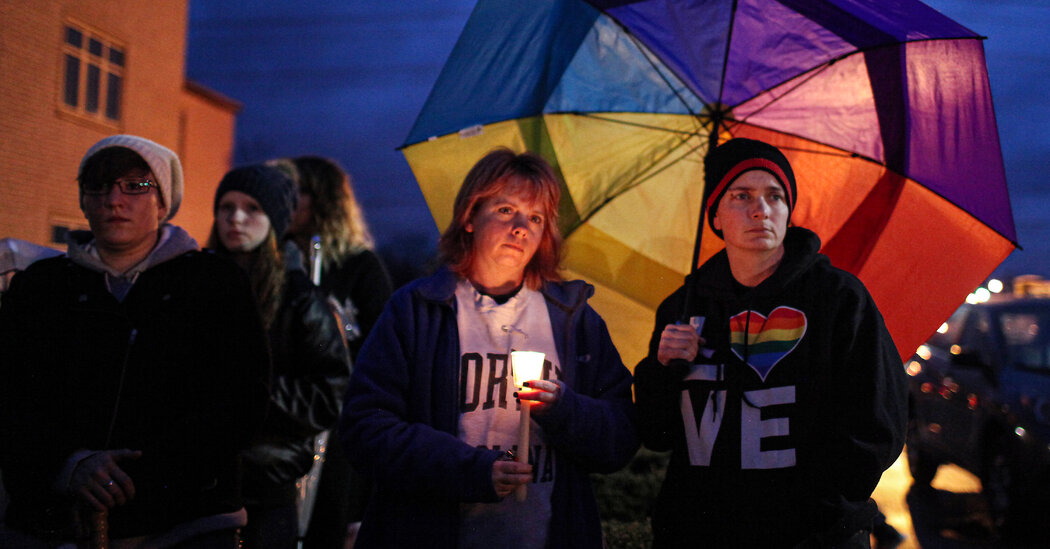Transgender people in Denmark have a significantly higher risk of suicide than other groups, according to an exhaustive analysis of health and legal records from nearly seven million people over the last four decades. The study is the first in the world to analyze national suicide data for this group.
Transgender people in the country had 7.7 times the rate of suicide attempts and 3.5 times the rate of suicide deaths compared with the rest of the population, according to the records analyzed in the study, though suicide rates in all groups decreased over time. And transgender people in Denmark died — by suicide or other causes — at younger ages than others.
“This is beyond doubt a huge problem that needs to be looked at,” said Dr. Morten Frisch, a sexual health epidemiologist at Statens Serum Institut in Copenhagen and a co-author of the new study.
The findings, published on Tuesday in the Journal of the American Medical Association, come at a charged political moment in the United States, where Republican lawmakers across the country have enacted laws targeting sexuality and gender identity, restricting drag performances, bathroom use for transgender people and gender-related medical care.
Studies of L.G.B.T.Q. people in the United States have shown that they have high rates of suicidal thoughts and attempts, putting them at high risk of death by suicide. But with scant data on actual deaths, suicide risk has become a matter of heated speculation and debate. Some Republicans have argued that suicides among transgender people are rare, while some L.G.B.T.Q. advocates have declared that the new laws could lead more young transgender people to die by suicide.
“This offers a stark rebuttal to some of those political arguments suggesting suicide risk in these groups are exaggerated,” said Ann Haas, an emeritus professor at the City University of New York who has studied suicide risks among L.G.B.T.Q. people for two decades.
But, Dr. Haas added, “This is not a time to use data for any political recrimination.”
The United States, like most countries, does not have information about the sexual orientation or gender identity of people who die violent deaths because this information is not recorded on death certificates. A few death investigators are trying to collect such data by interviewing the friends and family of the deceased, though progress has been slow.
Denmark, however, has a centralized data repository for all of its citizens, enabling researchers to conduct massive and rigorously controlled studies.
The authors of the new report identified nearly 3,800 transgender people in Denmark by pulling data from two sources: hospital records and applications for legal gender changes. Among that group, nearly 43 percent had a psychiatric diagnosis, compared with 7 percent of the nontransgender group.
The study identified 92 suicide attempts and 12 suicide deaths in the transgender group between 1980 and 2021, a rate considerably higher than what was found in the nontransgender group. The researchers said there were most likely other suicides that were not captured in the data because no records indicated the person’s gender identity. The study also found the rate of other, nonsuicide deaths in the transgender group was nearly double the rate of the nontransgender group.
The United States and Denmark have comparable suicide rates — 14 per 100,000 people in the entire population — suggesting that the study’s findings may apply in the United States as well, researchers said.
“Trans people face widespread poverty, widespread discrimination, they’re more likely to experience homelessness, they’re overrepresented in our nation’s prison system, our nation’s foster care system,” said Gillian Branstetter, a communications strategist at the American Civil Liberties Union who focuses on transgender rights. “That material lack has very real consequences on their lives, up to and including early deaths.”
But the researchers cautioned against drawing overly broad conclusions about the calculated rates. For one thing, the raw number of suicides and attempts among transgender people was small.
Based on their search tools, the researchers found that approximately .06 percent of the Danish population was transgender. In contrast, the Williams Institute at the University of California, Los Angeles, has estimated, using survey data, that the number of people who self-identify as transgender in the United States is 10 times higher than that. That might mean that a lot of transgender people in Denmark — and especially the increasing number of younger people who identify as trans or nonbinary — were not captured in the data, and perhaps that the true suicide rate is different than reported, the researchers said.
“These surveys tend to include much broader spectrums of trans individuals, and we cannot be as certain that our results are as problematic in the broader group,” Dr. Frisch said.
If you are having thoughts of suicide, call or text 988 to reach the Suicide and Crisis Lifeline or go to SpeakingOfSuicide.com/resources for a list of additional resources.




